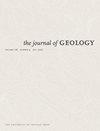大型热造山带的岩浆速度与大陆边缘弧的比较
IF 1.3
4区 地球科学
Q2 GEOLOGY
引用次数: 4
摘要
结合Variscan带波西米亚地块的地质年代学资料和基于地理信息系统的岩体空间分析,我们可以描述不同于大陆边缘弧旋回模式的岩体表观岩浆通量和幕式时间模式。前者被解释为反映了造山带的长期热构造演化和岩浆源由幔幔为主向壳内为主转变,同时伴随着以地壳生长为代价的地壳再循环日益重要。分析还表明,地壳增厚通常被认为是碰撞造山带深部成矿作用的主要原因,但其重要性可能相对低于晚期地幔剥离作用。本文章由计算机程序翻译,如有差异,请以英文原文为准。
Magmatic Tempos in Large Hot Orogens in Comparison with Continental Margin Arcs
Geochronologic data combined with a geographic information system-based spatial analysis of plutons in the Bohemian Massif, Variscan belt, allow us to describe the apparent magma fluxes and episodic temporal pattern of plutonism, different from the cyclic pattern of continental margin arcs. The former is interpreted as reflecting a secular thermotectonic evolution of the orogen and magma sources changing from mantle-dominated to intracrustal, paralleled by increasing significance of crustal recycling at the expense of crustal growth. The analysis also suggests that crustal thickening, commonly regarded as the main cause of plutonism in collisional orogens, may be of relatively lower significance than late-stage mantle delamination.
求助全文
通过发布文献求助,成功后即可免费获取论文全文。
去求助
来源期刊

Journal of Geology
地学-地质学
CiteScore
3.50
自引率
5.60%
发文量
0
审稿时长
3 months
期刊介绍:
One of the oldest journals in geology, The Journal of Geology has since 1893 promoted the systematic philosophical and fundamental study of geology.
The Journal publishes original research across a broad range of subfields in geology, including geophysics, geochemistry, sedimentology, geomorphology, petrology, plate tectonics, volcanology, structural geology, mineralogy, and planetary sciences. Many of its articles have wide appeal for geologists, present research of topical relevance, and offer new geological insights through the application of innovative approaches and methods.
 求助内容:
求助内容: 应助结果提醒方式:
应助结果提醒方式:


